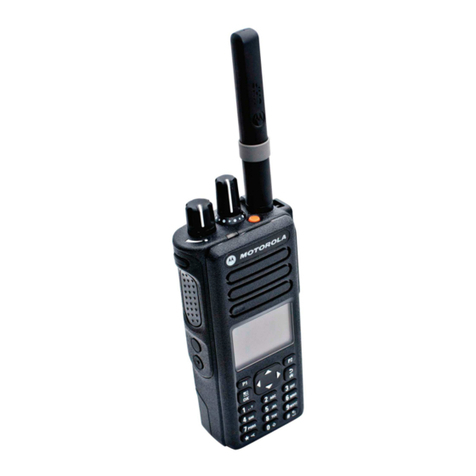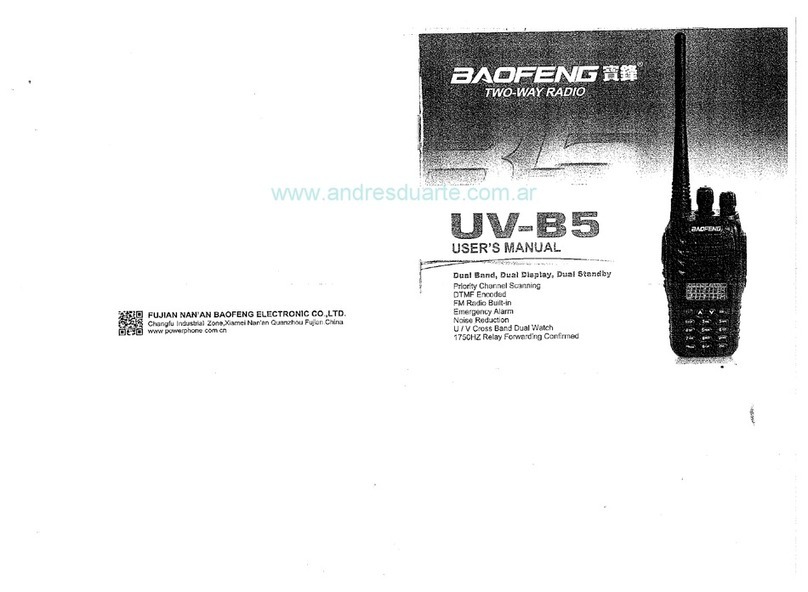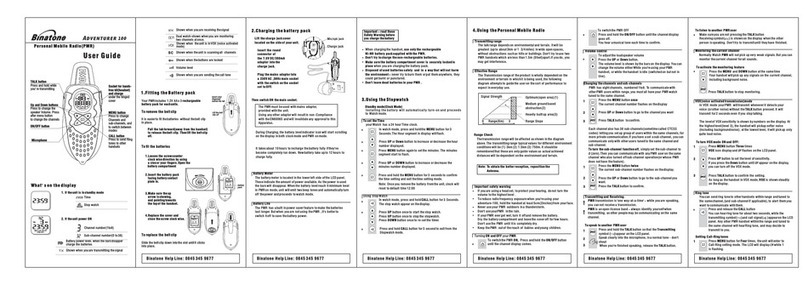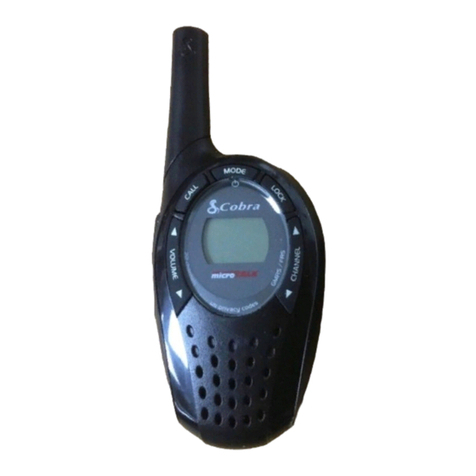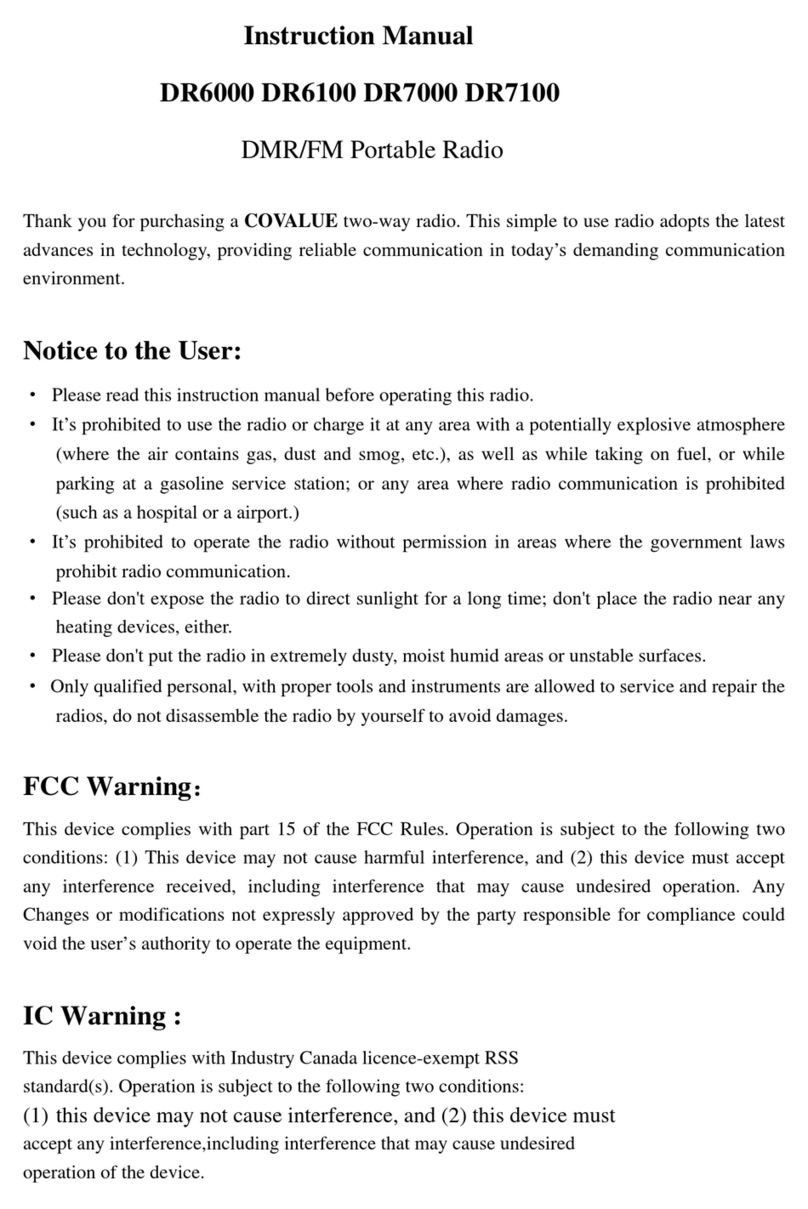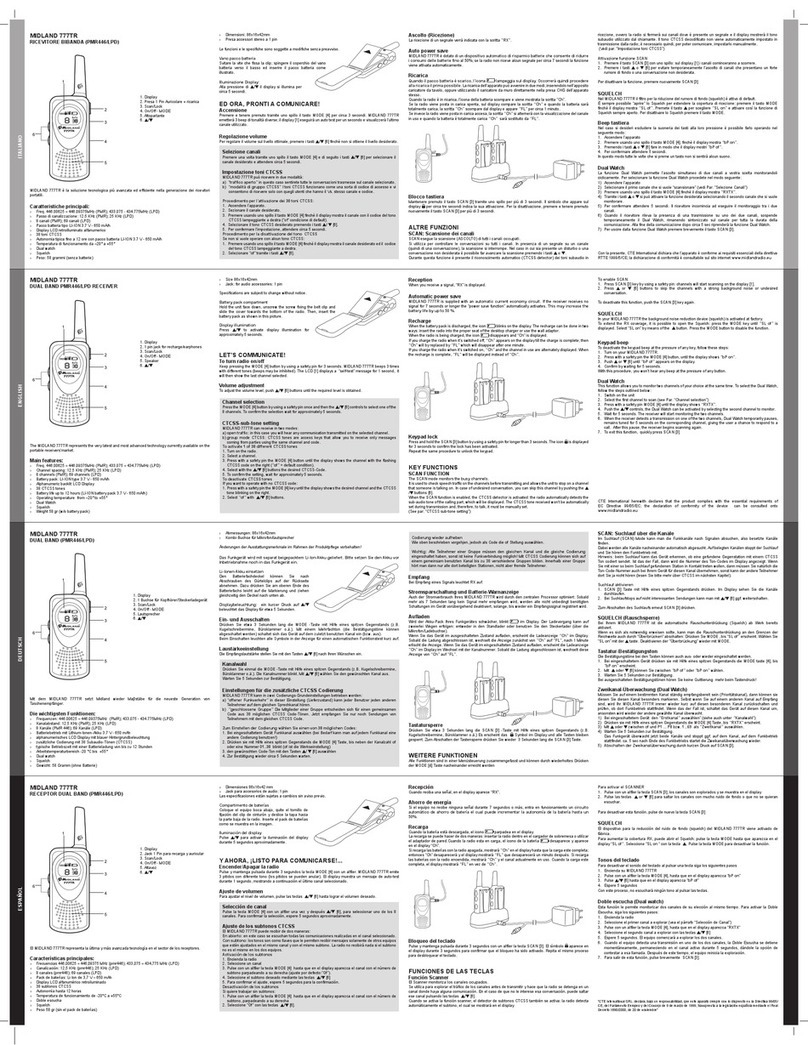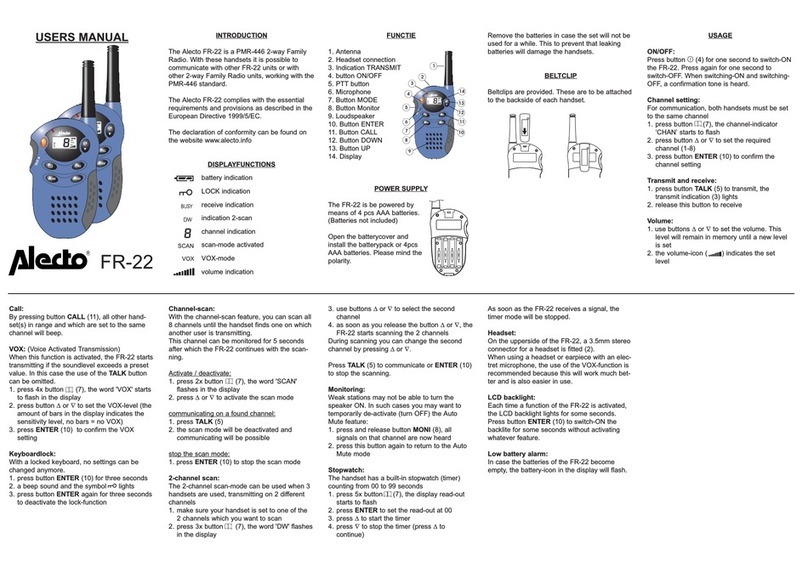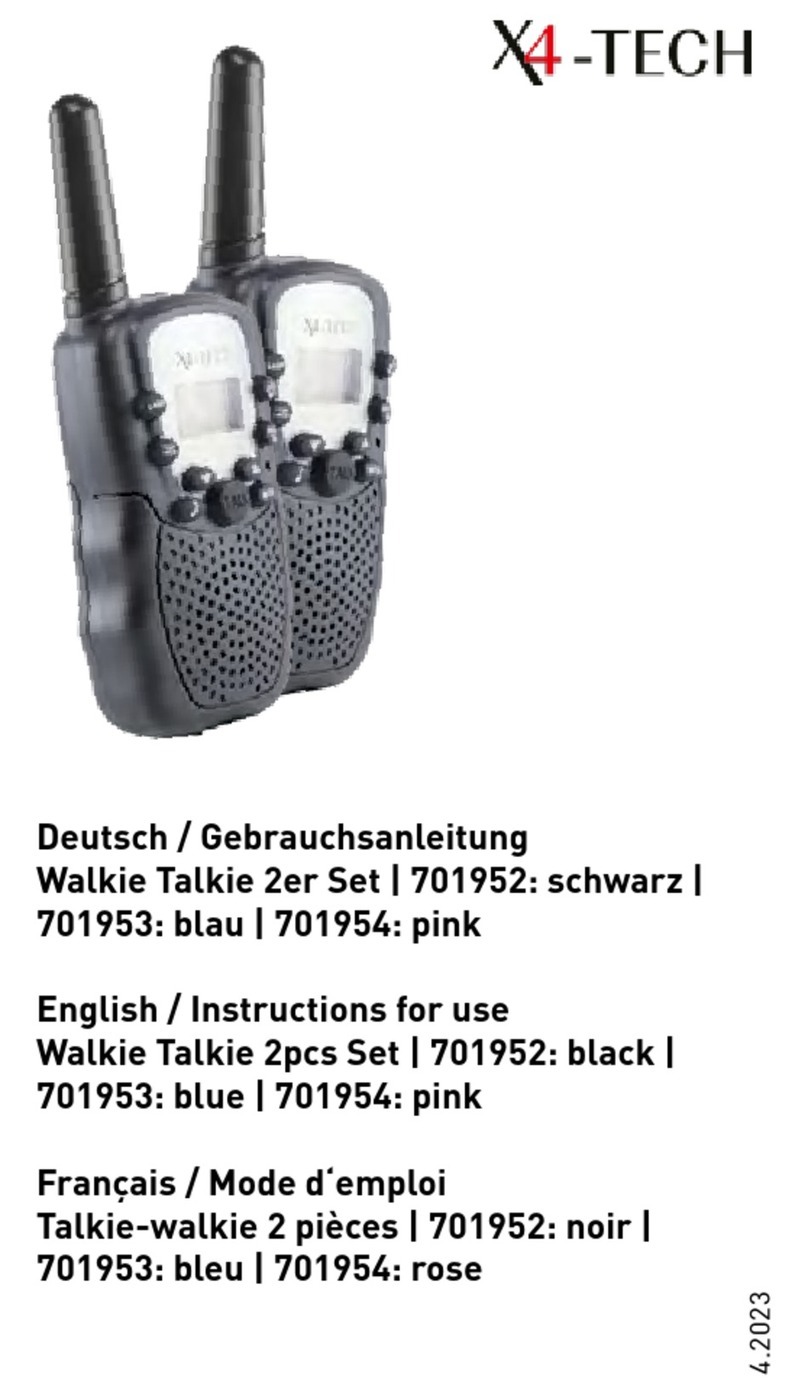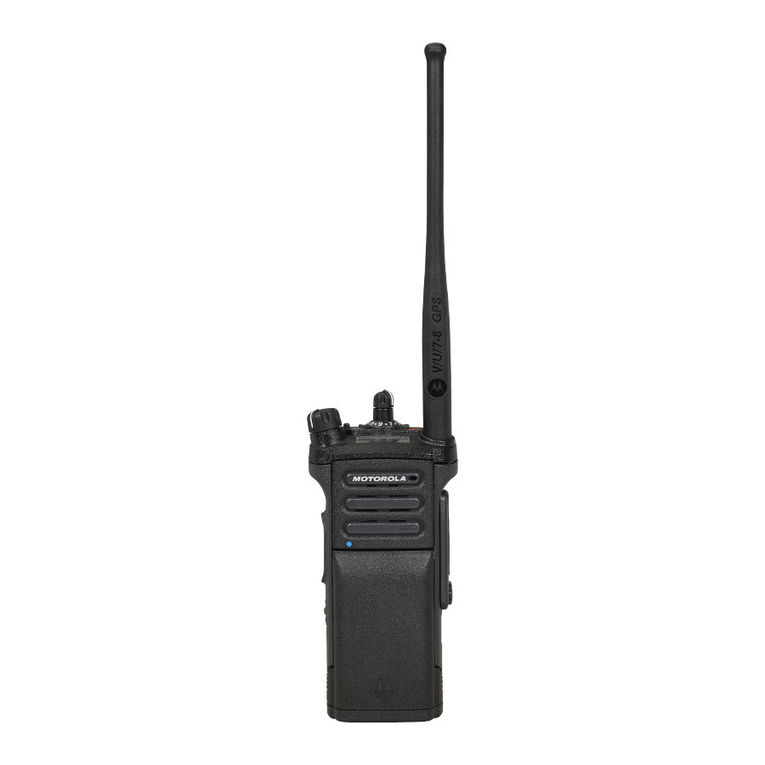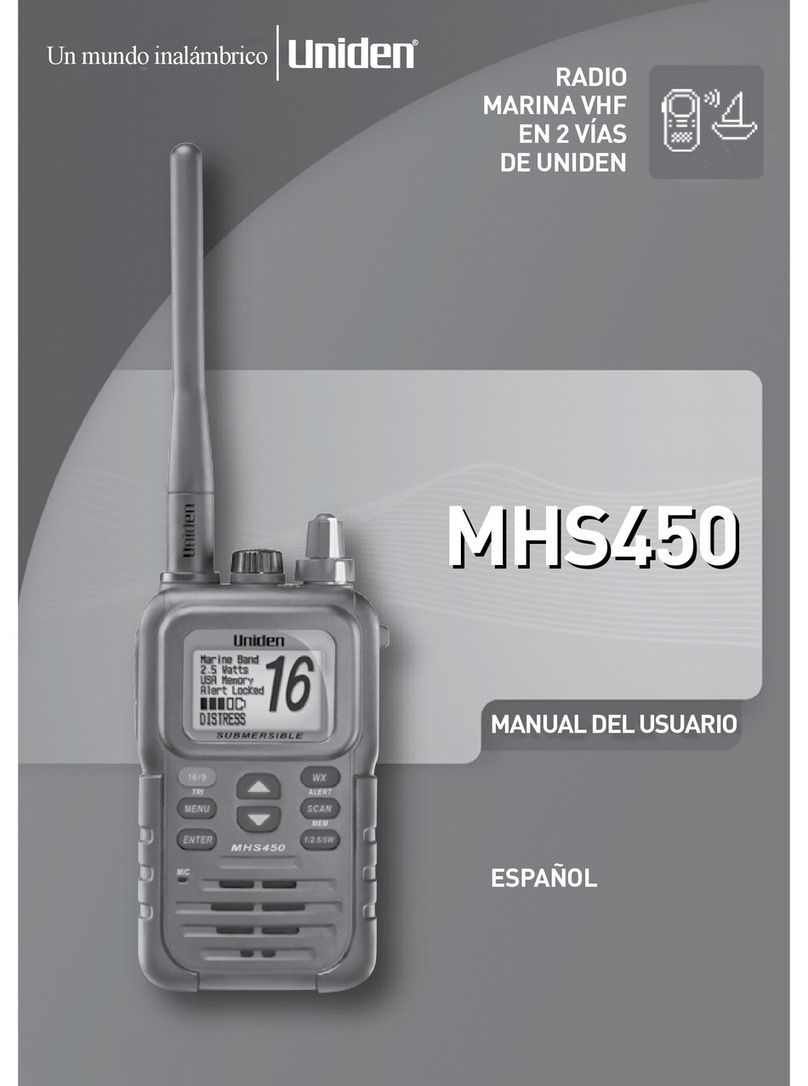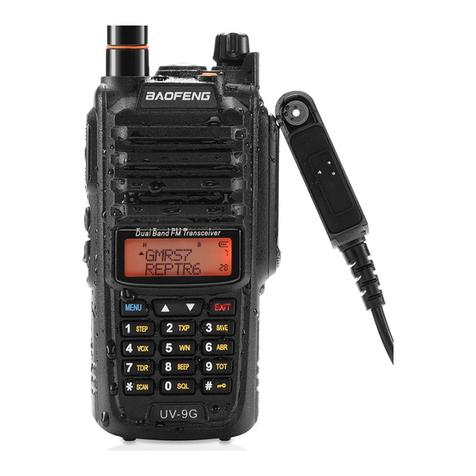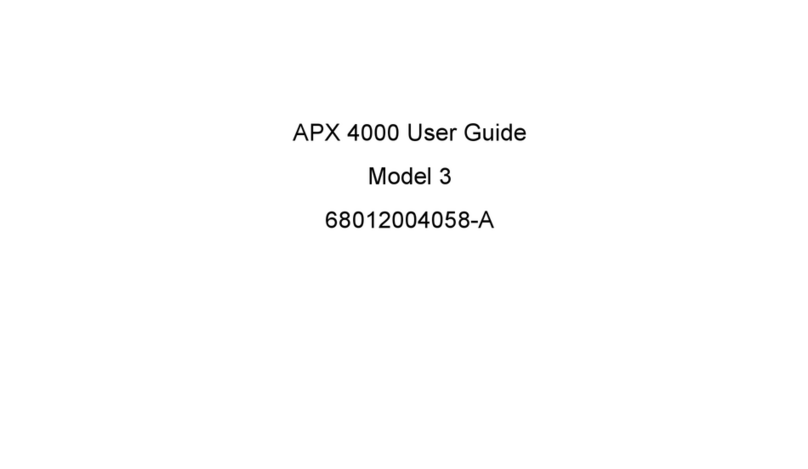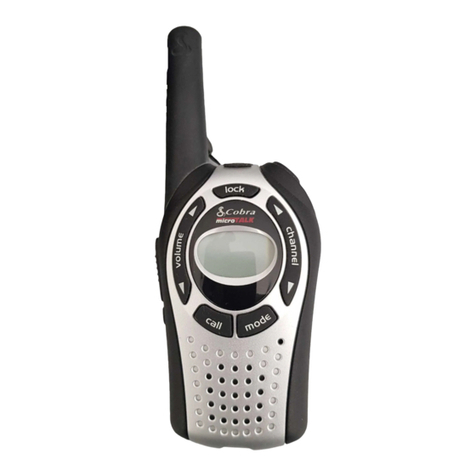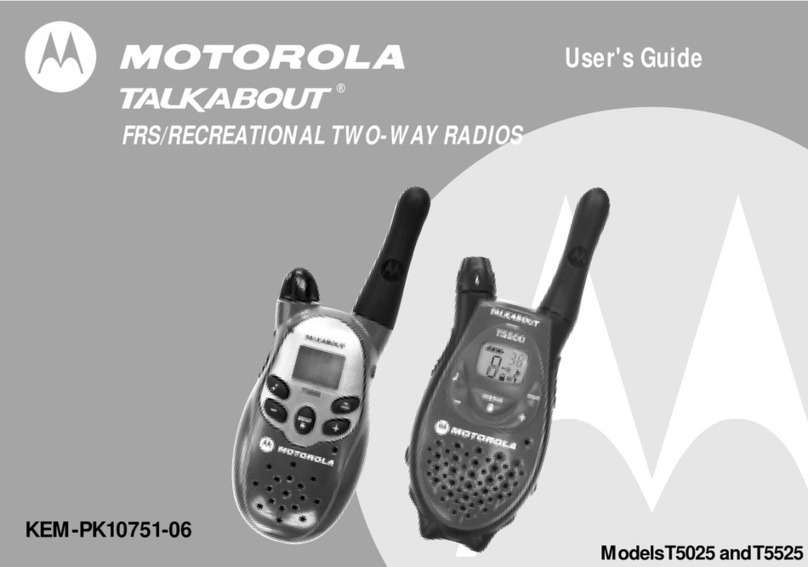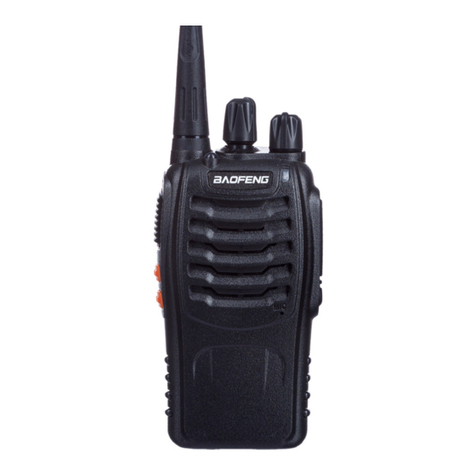Shenzhen Retevic Technology RT388 User manual

SCAN SCAN
RT388
Kids Walkie Talkie
User’s Guide
US

Before initial use, please check if the product inside the
box is in good condition or not. If there are any signs of
damage or missing parts, please feel free to contact the
carrier or seller.
Item Included
Walkie Talkie
Belt Clip
User’s Guide
Speaker / Mic
/ Charge Jack Lamp
Quantity(Pcs)
2
2
1
Product Inspection
Each unit takes 4 AAA batteries
Batteries are not included in the package. You need to
prepare batteries first to get the units work, and we
recommend you always using high quality AAA Alkaline
batteries.
Product Features
Radio Parts and Controls
Read this operating instruction carefully
before using your Retevis RT388 two way
radio, including the part on Product Safety
and RF Energy Exposure Compliance
CAUTION
SCAN
Lamp
Channel /
Menu Item
CTCSS /
Menu Option
Power Button
TX / RX Icon
Volume
MENU Button
Microphone
Up Button
Monitor Button
Scanning
Antenna
Vox
Lamp Button
Call Button
Down Button
Keypad Lock
Scan Button
Battery Level
Talk Button
Speaker
1

Belt Clip
Kids can clip the units to their pocket or elsewhere while
they are on the go.
Call Tone Button
By pressing button , you can inform other radio users
in your group that you want to talk or have finished
talking. When button is pressed, a tone would be
transmitted.
LCD Display
Various information accessible at one glance, including
channel number, CTCSS code, volume level and other
status of the radio.
On/Off Power Button
Press and hold this button to turn on/off the radio.
Lamp Button
By pressing “LAMP” button to turn on/off the flashlight.
Convenient for those who use the radio at night.
Scan Button
Press button to detect channels with activities or
stop scanning.
MENU/ Button
Switch on/off the functions you want to start or stop.
You can also lock the channle by this button.
Monitor Button
Enable you to continuously monitor weak signals.
Talk Button
Press and hold this button to talk and let go to listen.
Up and Down Key
To select channels, set CTCSS code, adjust volume
level, listening volume and other usage.
Speaker/Mic/Charger Jack
You can use the unit with external speaker/ Mic, or give
the unit a charge through this jack.
Product Features
Product number
Frequency range
Channel number
Channel spacing
Working voltage
Frequency stability
Operating temperature range
The antenna impedance
Overall dimensions
Weight
RT388
FRS
22
12.5KHz
4.8V
±2.5ppm
-20℃~50℃
50Ω
140*55*28mm
79g
TECHNICAL PARAMETERS
Rf power
Modulation method
Noise and harmonic
Residual Radiation
Modulation distortion
Maximum deviation
0.5W
11kΦF3E
<-40dB
≤-35dB
≤7%
≤±5KHz
TRANSMITER
2

How to assemble and remove the belt clip
Slide the clip into the slot on the back of the radio until
it is snapped into place.
-To remove
Gently pull the lock tab, and then push up the belt clip
to remove it from the radio.
Installation
Turning on the radio
Press and hold button for three
seconds. A short audible beep and
a display of the LCD screen shows
that the radio is on.
Operation
How to install or replace batteries
Make sure the radio is turned off;
Remove the belt clip;
Slide and lift the battery compartment cover;
Insert 4 AAA batteries with correct polarity into per radio;
Close the battery cover and attach the belt clip.
(Note: Please remove the batteries if the units are not
used for a long time)
How to attach the strap to the belt clip
Thread the strap through the hole on the belt clip;
Thread the other end of the strap through the string,
then pull it to secure (See Pic 3).
Product Features
The sensitivity
Modulation receiver bandwidth
Adjacent selective
Intermodulation interference resistance
Spurious response inhibition
Audio output power
Audio distortion
Channel
1
2
3
4
5
6
7
8
9
10
11
Frequency
462.5625
462.5875
462.6125
462.6375
462.6625
462.6875
462.7125
467.5625
467.5875
467.6125
467.6375
Channel
12
13
14
15
16
17
18
19
20
21
22
Frequency
467.6625
467.6875
467.7125
462.5500
462.5750
462.6000
462.6250
462.6500
462.6750
462.7000
462.7250
Pic 1 Pic 2 Pic 3
≤0.2uV
±5KHz
≥40dB
≥35dB
≥70dB
≥300mW
≤8%
RECEIVER
3

Turning off the radio
Press and hold until an audible beep is heard and
the screen disappears.
Adjusting volume level
Use the up/down key to increase or
decrease the volume. And you can
always find the volume level indicator
in the lower right corner of the screen.
Receiving
The radio is ready to receive signals when it is tuned to
the channel that has the same frequency and CTCSS
code as the one that is transmitting. To receive signals,
you also need to leave this very radio’s TALK button
untouched. When signals have been received on the
current channel, RX icon will appear in the lower right
corner of the screen.
Transmitting
Press and hold “TALK” button to talk
to another person. Release the button
for response.
TX Icon will appear in the lower right
corner of the screen when radio is
transmitting.
To get maximum clarity, please speak directly to the
microphone and hold the mic 2 inches from your mouth.
Note: RT388 can only work together when the units are
tuned to the same channel and have the same
CTCSS code on that channel.
Channel Lock
Press and hold MENU button until
icon appears on the screen, which
indicates that the radio is locked to
the current channel, namely, you
cannot switch it to another channel
under this status.
To unlock the channel lock function, press MENU
button again for about 2 seconds.
Flashlight
The radio is equipped with flashlight
function, which will bring a lot of
convenience in the dark.
Press “LAMP” button to turn the
flashlight on. And the process to turn
it off is the same as turning it on, just
press “LAMP” button, that’s it.
Select Channel
These units have 22 Channels available for US and
Canada market.
To select any among the 22, you need press MENU
button once, then the channel number on the screen
will blink;
Using up/down key to select the channel you want to
communicate on;
Press TALK button to choose the desired channel and
return to normal mode. Or press MENU button to confirm
the channel and go to set CTCSS code.
4

Set CTCSS Code
Within a channel, you can partly
avoid interference from other radios
by setting CTCSS code (01-38)
while code 00 refers to no privacy
code is selected. To select any
among the 38, you need press MENU button twice,
then the CTCSS code on the screen will blink;
Using up/down key to select the code;
Press TALK button to confirm the desired code and go
back to normal mode.
Note: RT388 can only work together when the units are
tuned to the same channel and have the same
CTCSS code on that channel.
VOX for Hands-free
When VOX is activated, there is no
need to press TALK button to talk.
Tap MENU button three times, then
“VOX” and VOX sensitivity level
(OF,01,02,03) will be displayed on
the screen.
You can adjust VOX sensitivity level by pressing up/
down key.
Note: OF means VOX function is inactivated; 03 is the
highest sensitivity setting and 01 the lowest.
Therefore, level 03 is recommended when the
radio is used in quiet surroundings and 01 for
noisy environment.
Select Call Tone
To inform other radio users in your group that you want
to talk or you have finished talking by transmitting a
tone to their radios.
Press MENU button four times,
then “CA” and call tone number
(01, 02, 03, 04, 05, 06, 07, 08, 09,
10) will blink on the screen;
Using up/down key to select the
tone you prefer;
Press TALK button to confirm the desired tone and go
back to normal mode.
As to how to send the desired call tone to another party,
please go and check “ Call another party” on Page.
Channel Scan
Convenient to detect channels with
activities.
When button is tapped, the radio
will automatically scan for channels
with activities. The scanning will
stop when channels with activities are found, and the
radio will play what it detects on that channel.
To continue the scan, just press button .
Note: When a channel with activities is detected, you
can join the conversation and back away from the
scan by pressing TALK button.
Call Another Party
Press button to transmit a call tone to
other radios in your group so that they
can be prepared when you want to talk
or you have finished talking. (See how
to select call tone on Page)
Note: Another party can only receive the call tone when
the following requirements are met at the same
time.
vox
5

1.The receiving unit is on the same channel and shares
the same CTCSS code as the unit that sends the call
tone;
2. The receiving unit is within the communication range.
Monitor
To receive weak signals from other
radios in your group, all you need to do
is press MON button.
If you want to continue the monitoring,
please press MON button for at least
3 seconds. And press MON button again to stop.
Battery Level Indicator
Displayed in the lower left corner of the screen,
convenient to know how much battery power is
remained.
When the indicator on the screen blinks, it means that
the batteries need to be changed(when using regular
AAA batteries) or charged(when using NiMH
rechargeable batteries).
External Headset/Microphone Jack
The unit support external headset connection.
To talk or listen through an external earpiece,
you need to remove the rubber hole cap at the
top of the unit, insert the favorable/suitable
headphone plug into the accessory jack, and
then put on your earpiece.
Charging(Optional)
If you want the units to be rechargeable, please use
rechargeable AAA batteries (not included).
Then you can charge the units by
plugging the charger(not included)’s
connector into the accessory jack
and then connect the other end of
the charger to a general socket or
somewhere else alike.
Below is information on specially
designated charger and rechargeable AAA batteries.
Note
When external earpiece is applied
Please adjust volume level accordingly.
Turn the radio off immediately if your ears feel
uncomfortable or itchy with headsets on.
Don’t use the units in places that might cause explosion
or fire
Such as gas stations, unshielded electrical installations
and other unsafe places.
Simple Maintenance Tips
Gently wipe the dust or dirt off with a dry soft clean cloth.
Don’t use any cleaning chemicals, as they can damage
the units.
When the radio is dropped into water, turn it off
immediately. Dry the outside of the radio with a clean
and soft cloth. Remove batteries and dry them, too. Put
the unit in a cool dry place to dry out all moisture.
In case that any other problem or malfunction occurs
during your use, please don’t dissemble the radio’s
circuit or hardware by yourself. You are welcome to
send the unit back to the seller or contact our customer
service for help.
6

Annex I
Troubleshooting
1. Couldn’t turn the units on
A. Check if batteries are installed properly;
B. Check if batteries need to be changed (when
using regular batteries), or charged (when using
NiMH batteries)
2. When reception or transmission is poor,
A. Increasing volume level; Pressing Mon button to
receive weak signals
B. Check battery level
The Stylized RETEVIS logo are trademarks or register-
ed trademarks of Shenzhen Retevis Technology Co.,
Ltd. And are used under license. All other trademarks
are the property of their respective owners.
2017 Shenzhen Retevis Technology Co., Ltd. All rights
reserved.
Remarks:
1. This guarantee card should be kept by the user, no
replacement if lost.
2. Most new products carry a two-year manufacturer’s
warranty from the date of purchase. Further details,
pls read http://www.retevis.com/after-sale/
3. The user can get warranty and after-sales service
as below:
• Contact the seller where you buy.
• Products Repaired by Our Local Repair Center
4. For warranty service, you will need to provide a
receipt proof of purchase from the actual seller for
verification
Exclusions from Warranty Coverage:
1. To any product damaged by accident.
2. In the event of misuse or abuse of the product or as
a result of unauthorized alterations or repairs.
3. If the serial number has been altered, defaced, or
removed.
Model Number:
Serial Number:
Purchasing Date:
Dealer:
Telephone:
User’s Name:
Telephone:
Country:
Address:
Post Code:
Email:
Guarantee
7

RF ENERGY EXPOSURE AND PRODUCT SAFETY
GUIDE FOR PORTABLE WALKIE TALKIE
This walkie talkie uses electromagnetic energy in the
radio frequency (RF) spectrum to provide communicati-
ons between two or more users over a distance. It uses
radio frequency (RF) energy or radio waves to send
and receive calls. RF energy is one form of electroma-
gnetic energy. Other forms include, but are not limited
to, sunlight and x-rays. RF energy, however, should not
be confused with these other forms of electromagnetic
energy, which when used improperly, can cause
biological damage. Very high levels of x-rays, for
example, can damage tissues and genetic material.
Experts in science, engineering, medicine, health, and
industry work with organizations to develop standards
for safe exposure to RF energy. These standards
provide recommended levels of RF exposure for both
workers and the general public. These recommended
RF exposure levels include substantial margins of
protection.
All Retevis walkie talkie are designed, manufactured,
and tested to ensure they meet government-established
8
Warnings
ATTENTION!
Before using this radio, read this guide which
contains important operating instructions for
safe usage and RF energy awareness and
control for compliance with applicable stan-
dards and regulations.
RF exposure levels. In addition, manufacturers also
recommend specific operating instructions to users of
walkie talkie. These instructions are important because
they inform users about RF energy exposure and
provide simple procedures on how to control it.
Please refer to the following websites for more
information on what RF energy exposure is and how
to control your exposure to assure compliance with
established RF exposure limits: http://www.who.int/en
Local Government Regulations
When walkie talkie are used as a consequence of em-
ployment, the Local Government Regulations requires
users to be fully aware of and able to control their
exposure to meet occupational requirements. Exposure
awareness can be facilitated by the use of a product
label directing users to specific user awareness
information. Your Retevis walkie talkie has a RF
Exposure Product Label. Also, your Retevis user
manual, or separate safety booklet includes information
and operating instructions required to control your RF
exposure and to satisfy compliance requirements.
Radio License
Governments keep the radios in classification, most
of the classified walkie-talkie need to get local
government License, and operation is allowed. The
detailed classification and the use of your two radios,
please contact the local government radio management
departments. For the following specified classification:
the USA FRS, Australian CB, the individual license is
not required.

9
Compliance with RF Exposure Standards (If
appropriate, Reference to the actual product’s
Safety Marking)
Your Retevis walkie talkie is designed and tested to
comply with a number of national and International
standards and guidelines (listed below) for human
exposure to radio frequency electro-magnetic energy.
FCC ID
The FCCID means: This radio complies with the IEEE
(FCC) and ICNIRP exposure limits for occupational
/controlled RF exposure environments at operating
duty factors of up to 50% talk-50% listen and is
approved for occupational use only.
IC ID
This device complies with Industry Canada
license-exempt RSS standard(s). Operation is subject
to the following two conditions:
(1) This device may not cause interference, and
(2) This device must accept any interference, including
interference that may cause undesired operation of
the device.
In terms of measuring RF energy for compliance with
these exposure guidelines, your radio generates
measurable RF energy only while it is transmitting
(during talking), not when it is receiving (listening) or
in standby mode.
Note: The approved batteries, supplied with this radio,
are rated for a 5-5-90 duty factor (5% talk-5%
listen-90% standby) even though this radio
complies with FCC occupational exposure limits
and may operate at duty factors of up to 50% talk.
RF energy exposure standards and guidelines (if
appropriate)
Your Retevis walkie talkie complies with the following
RF energy exposure standards and guidelines:
• United States Federal Communications Commission
(FCC), Code of Federal Regulations; 47 CFR part 2
sub-part J.
• American National Standards Institute (ANSI) /
Institute of Electrical & Electronic Engineers (IEEE)
C95. 1-2005
• IEEE Std. 1528:2013 and KDB447498, Evaluating
Compliance with FCC Guidelines for Human Exposure
to Radio Frequency Electromagnetic Fields.
• Institute of Electrical and Electronic Engineers
(IEEE) C95.3-2002
• International Commission on Non-Ionizing Radiation
Protection (ICNIRP)
• Ministry of Health (Canada) Safety Code 6 & Industry
Canada RSS-102.
• International Electrotechnical Com-mission
IEC62209-2:2010]
RF Exposure Compliance and Control Guidelines
and Operating Instructions
To control your exposure and ensure compliance with
the occupational/controlled environment exposure limits,
always adhere to the following procedures.
Guidelines:
• User awareness instructions should accompany the
device when transferred to other users.
• Do not use this device if the operational requirements
described herein are not met.

10
Operating Instructions:
• Transmit no more than the rated duty factor of 50%
of the time. To Transmit (Talk), push the Push To Talk
(PTT) button. To receive calls (listen), release the
PTT button. Transmitting 50% of the time, or less, is
important because the radio generates measurable
RF energy exposure only when transmitting in terms
of measuring for standards compliance.
• Transmit only when people outside the vehicle are at
least the recommended minimum lateral distance
away from a properly installed according to installation
instructions, externally mounted antenna.
• When operating in front of the face, worn on the body,
always place the radio in a Retevis approved clip,
holder, holster, case, or body harness for this product.
Using approved body-worn accessories is important
because the use of Non-Retevis approved accessories
may result in exposure levels, which exceed the IEEE
/ICNIRP occupational/controlled environment RF
exposure limits.
• If you are not using a body worn accessory and are
not using the radio in the intended use position, in
front of the face or at the body in the PTT mode or
alongside of the head in the phone mode, then ensure
the antenna and the radio are kept 2.5 cm (one inch)
from the body when transmitting. Keeping the radio at
a proper distance is important because RF exposures
decrease with increasing distance from the antenna.
Hand-held Mode
• Hold the radio in a vertical position with
the microphone (and other parts of the
radio including the antenna)
WARNING
Avoid Burns
Small Parts. Not for children under 3 years.
Turn off your radio power in the following
conditions:
• Turn off your radio before removing (installing)
a battery or accessory or when charging
battery.
• Turn off your radio when you are in a
potentially hazardous environments: Near
electrical blasting caps, in a blasting area,
in explosive atmospheres (inflammable gas,
dust particles, metallic powders, grain powders,
etc.).
• Turn off your radio while taking on fuel or
while parked at gasoline service stations.
atleast 2.5 cm (one inch) away from the nose or lips.
The antenna should be kept away from the eyes.
Keeping the radio at a proper distance is important
as RF exposure decreases with increasing distance
from the antenna.
Phone Mode
• When placing or receiving a phone call, hold your
radio product as you would a wireless telephone.
Speak directly into the microphone.
Electromagnetic Interference/Compatibility
Note: Nearly every electronic device is susceptible to
electromagnetic interference (EMI) if inadequately
shielded, designed, or otherwise configured for
electromagnetic compatibility.

11
WARNING
from the implantable device to minimize the
potential for interference.
- Hearing Aids
Some digital wireless radios may interfere with
some hearing aids. In the event of such interf-
erence, you may want to consult your hearing
aid manufacturer to discuss alternatives.
- Other Medical Devices
If you use any other personal medical device,
consult the manufacturer of your device to
determine if it is adequately shielded from RF
energy. Your physician may be able to assist
you in obtaining this information.
Protect your hearing:
• Use the lowest volume necessary to do your
job.
• Turn up the volume only if you are in noisy
surroundings.
• Turn down the volume before adding headset
or earpiece.
• Limit the amount of time you use headsets or
earpieces at high volume.
• When using the radio without a headset or
earpiece, do not place the radio's speaker
directly against your ear.
Note: Exposure to loud noises from any source
for extended periods of time may temporarily
or permanently affect your hearing. The louder
the radio's volume, the less time is required
before your hearing could be affected. Hearing
To avoid electromagnetic interference and/
or compatibility conflicts
• Turn off your radio in any facility where posted
notices instruct you to do so, hospitals or
health care facilities (Pacemakers, Hearing
Aids and Other Medical Devices) may be
using equipment that is sensitive to external
RF energy.
• Turn off your radio when on board an aircraft.
Any use of a radio must be in accordance
with applicable regulations per airline crew
instructions.
Note:
- Pacemakers
Defibrillators or other Implanted Medical
Devices Persons with pacemakers, Implantable
Cardioverter-Defibrillators (ICDs) or other active
implantable medical devices (AIMD) should:
• ALWAYS keep the radio more than 15cm from
their pacemaker when the radio is turned on.
• Consult with their physicians regarding the
potential risk of interference from radio
frequency transmitters, such as portable
radios (poorly shielded medical devices may
be more susceptible to interference).
• Turn the radio OFF immediately if they have
any reason to suspect that interference is
taking place.
• Do not carry the radio in a chest pocket or
near the implantation site, and carry or use
the radio on the opposite side of their body

12
WARNING
damage from loud noise is sometimes undete-
ctable at first and can have a cumulative effect.
Avoid Burns
- Forbid
• Do not use charger outdoors or in moist envi-
ronments, use only in dry locations/conditions.
• Do not disassemble the charger, that may
result in risk of electrical shock or fire.
• Do not operate the charger if it has been
broken or damaged in any way.
• Do not place a portable radio in the area over
an air bag or in the air bag deployment area.
The radio may be propelled with great force
and cause serious injury to occupants of the
vehicle when the air bag inflates.
- To reduce risk
• Pull by the plug rather than the cord when
disconnecting the charger.
• Unplug the charger from the AC outlet before
attempting any maintenance or cleaning.
• Contact Retevis for assistance regarding
repairs and service.
- Use of Communication Devices While
Driving
• Always check the laws and regulations on the
use of radios in the countries and areas where
you drive.
• Give your full attention to driving and to the
road.
• If available, use the hands-free facility.
WARNING
• If driving conditions or regulations require it,
pull off the road and park before making or
answering a call.
Approved Accessories
• This radio meets the RF exposure guidelines
when used with the Retevis accessories
supplied or designated for the product.
Use of other accessories may not ensure
compliance with the RF exposure guidelines
and may violate regulations.
• For a list of Retevis-approved accessories for
your radio model, visit the following website:
http://www.Retevis.com

Table of contents
